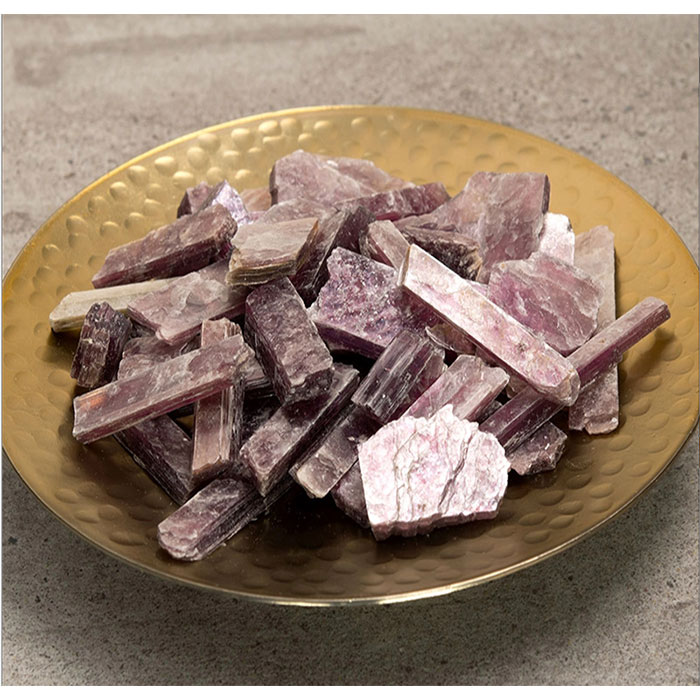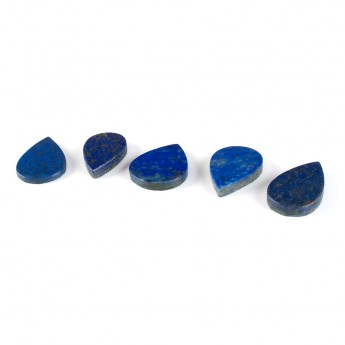Lapis Lazuli: Properties, Facts and Photos

| Contents 1. What is Lapis Lazuli? 2. The Meaning of Lapis Lazuli 3. History of Lapis Lazuli 4. Mask of Tutankhamun 5. Real Lapis or Fake? 6. Article Pictures 7. Shop Lapis Lazuli |
What is Lapis Lazuli?
Lapis lazuli is a deep-blue metamorphic rock prized for its colour for thousands of years.
Lapis can only be found in a few places around the world because specific geological conditions are required for the stone to form. This has enabled historians to reconstruct ancient trade routes.
Lapis lazuli is a rock, not a mineral, because it's composed of several different minerals.
The golden inclusions of pyrite often present in lapis stones come from the mineral lazurite. Lazurite is one of several minerals that make up lapis lazuli. It's also responsible for the blue colour.
Other minerals that may be present include white calcite, diopside, enstatite, mica, sodalite, haüyne, (I believe lazurite is a variety of haüyne ) and hornblende.
Where Does Lapis Come From?
Most of the world's lapis lazuli comes from the Sar-e Sang deposit in Badakhshan Province, northeast Afghanistan. The stone has been mined there for more than 6,500 years.
The Sar-e Sang mines are some of the world's oldest and most difficult to reach. The only access is by a network of narrow trails high on treacherous slopes in the Hindu Kush Mountains.
Although several mines were once in operation, only one is in use today. Lapis lazuli can also be found in Siberia and Chile, but not in such abundance. In recent years, the quality of some stone from Chile has rivalled that of Afghanistan.
Lapis lazuli can also be found in Siberia and Chile, but not in such abundance. In recent years, the quality of some stone from Chile has rivalled that of Afghanistan.
Lapis can also be found in a few other countries but in relatively small quantities.
On the Mohs scale of hardness, lapis lazuli grades 5 to 5.5, so stones scratch quite easily.
Source of the Pigment Ultramarine
Ultramarine, a vibrant and highly prized deep blue pigment, was historically produced by grinding the mineral lazurite. However, because lazurite was extremely rare, lapis lazuli, which contains lazurite, was often used instead.
The name 'ultramarine' comes from the Latin 'ultra mare,' meaning "beyond the sea," because lapis was sourced from Afghanistan, far beyond Europe.
To create the ultramarine pigment, the lapis stone was crushed into a fine powder and combined with a mixture of resin, wax and other materials to extract the blue colour. After grinding in a mortar, the powder was washed with alkaline substances to separate the blue pigment from other minerals in the stone, such as calcite and pyrite.
The result was a pure blue pigment, but the process was long and costly, making ultramarine one of the most expensive pigments.
Used in art, mainly for paintings, from ancient times until 1826, it was once said to be more valuable than gold. It stopped being used when a synthetic alternative was produced.
It has been claimed that Michelangelo's 'The Entombment' was left unfinished because he could not afford ultramarine, though it may also have been because it was in short supply.
The Italian painter Rafael, known for his frescoes in the Vatican, is said to have only used it for the final coat of his paintings. It's believed he may have used azurite instead for the base layers because it was cheaper.
The Meaning of 'Lapis Lazuli'
The name 'Lapis Lazuli' translates to 'stone from the sky' or 'stone from heaven.'
The word 'lapis' comes from Latin for 'stone', while 'lazuli' comes from 'lazulum', from the Arabic word 'lāzaward.' 'Lāzaward' comes from the Persian 'lājevard.' These words all relate to the sky or heaven in reference to the deep blue colour of many lapis stones.
Lapis, which has a long and interesting history, was first mined and used by civilisations in what is today Afghanistan and Pakistan. The Persian word 'lājevard' is likely to have been the stone's original name.
As it travelled along ancient trade routes and became more widely known, the Arabic word 'lāzaward' would have emerged. It would have changed from Arabic to Latin as lapis lazuli reached Europe.
Although not related to the meaning of lapis lazuli, the golden inclusions of pyrite
have been likened to stars in the sky due to their bright, shimmering appearance against the deep blue colour of the stone.
This striking visual resemblance has contributed to lapis lazuli being considered a stone of spiritual significance, often associated with the night sky or the heavens in various cultures.
Today, the word 'azul', from the Latin 'lazulum', is used in several languages to describe the colour blue.
History of Lapis Lazuli
The history of lapis lazuli can be traced back thousands of years. One of the oldest and best-known gemstones, it was highly sought after by some of the earliest civilisations, including Babylonia, Ur and ancient Egypt. The stone was often carved into amulets and talismans for jewellery and was also used in religious ceremonies.
Carvings found in ancient Egyptian tombs, including King Tutankhamun's, date back 3000 years BC. Tutankhamun's funerary mask is one of the world's most famous artefacts.
This priceless work of art features lapis, white quartz, obsidian, turquoise, amazonite, carnelian and coloured glass.
In his work, Theophrastus on Stones, the ancient Greek philosopher Theophrastus wrote about lapis lazuli, which was included in the group called 'Valuable Stones.'
Three hundred and fifty years later, Pliny the Elder, Roman author, naturalist and philosopher, described lapis as "a blue stone with spots of gold that was never transparent." The spots of gold referred to inclusions of the mineral pyrite, which was relatively unknown at this time.
When comparing lapis lazuli to azurite, Pliny said, "Lapis coloured like azurite is considered male." In ancient times, stones were either male or female. Darker stones with more distinctive characteristics were male, and those with less colour were female.
Blue stones with a more solid colour that didn't feature pyrite were known as 'cyanus' but the name is likely to have incorporated other dark blue-coloured stones.
In modern times, lapis lazuli has often been confused for sapphire, not because of any visible similarities or characteristics, but because in the ancient world, lapis lazuli was known as sappheiros.
Pliny wrote, "Sapphirus included with spots of gold is not suitable for engraving." This would have been because the pyrite was too hard to cut through.
The Romans adopted the word 'sapphirus' from the Greek 'sappheiros.'
In ancient Egypt, lapis was believed to open the heart to love and lead the soul into immortality. The Book of Exodus states 'sappir' was one of the twelve precious gemstones in the breastplate of the Jewish high priest.
During excavations of the royal graves in the ancient Sumerian city of Ur, artefacts featuring gold, silver and gemstones were discovered. Many exhibited exceptional craftsmanship, skill and artistry.
The wide range of materials indicates the presence of huge wealth and an extensive network of trade. This is apparent because many of the stones and metals are not found in the region.
Sumer was located between the Tigris and Euphrates rivers in Mesopotamia, modern-day Iraq. It was home to one of the earliest civilisations. Over 6000 items carved from lapis stone were found there.
The lapis, believed to have come from Afghanistan, was transported to countries including Mesopotamia, Ur, Egypt and India.
The 'golden lyre of Ur', crafted from gold and lapis lazuli, was found in the grave of a king during a 1928 British Museum expedition to Ur (modern-day Iraq). A fine example of ancient Sumerian art, it has been dated to approximately 3500 BC.
The lapis stone necklace in the adjacent photo comes from the same location.
The pictures link to a fascinating collection of photos of the golden lyre of Ur.
How to Tell Real Lapis from Fake?
Fake lapis lazuli is often produced using other natural rocks and minerals. Sodalite, azurite and calcite are two of the most common.
Low-grade lapis stone can also be dyed to make it more visually appealing. Paraffin is used to seal the dye and improve the polish.
In fake or enhanced lapis, white calcite naturally present in the stone is often dyed to give it a more uniform blue appearance. This makes the stone look more appealing and mimics the appearance of high-quality lapis, which can have very little or even no visible calcite.
However, it's relatively rare to find lapis lazuli without any calcite or pyrite at all. These distinctive inclusions are a typical characteristic. High-quality lapis lazuli with a deep, uniform colour and minimal calcite is considered more valuable, making dyeing a common enhancement technique for lower-grade or fake lapis stones.
Fake lapis lazuli is often dyed, so the colour should come off when touched with acetone (nail polish remover) or diluted hydrochloric acid. Any stone that's been dyed is likely to fade when exposed to UV light or high temperatures.
If an unusual mark is the reason you suspect your lapis lazuli may be fake, try pricking it with a hot needle. If plastic, paraffin or another filler has been used, you should smell burning.
The problem with most tests to establish whether any rock or mineral is genuine is that some damage will be caused.
Weight could also be a clue regarding fake lapis lazuli, depending on the material used. Sodalite will be lighter than a lapis stone of a similar size.
The pyrite inclusions in lapis are extremely difficult to reproduce effectively. In fake lapis, these golden specs may be recreated using metallic paint, although this becomes pretty obvious when the stone is magnified.
Ultimately, the best way to avoid being sold fake lapis lazuli is to purchase from a reputable and trustworthy source. Bear in mind that most lapis stones originate from suppliers in India, Pakistan, Afghanistan and China.
Article Pictures
The lapis lazuli at the top of our article is courtesy of James St.John.
The second photo is of lapis lazuli being polished in Afghanistan. The tumbled stones are from our collection.
The funerary mask of King Tutankhamun is in the Egyptian Museum in Cairo. The Golden Lyre of Ur and the lapis stone necklace are in the Penn Museum, Philadelphia.
All pictures, except for the lapis stones being polished, are clickable.
Pop-up photos: The snow quartz tumbled stones and mica are part of our collection. Turquoise, amazonite, pyrite, azurite - Courtesy of Stan Celestian. Diopside - Courtesy of The Arkenstone. Haüyne - Courtesy of Géry Parent.























